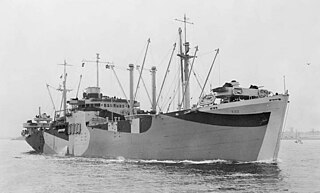
Type C1 was a designation for cargo ships built for the United States Maritime Commission before and during World War II. Total production was 493 ships built from 1940 to 1945. The first C1 types were the smallest of the three original Maritime Commission designs, meant for shorter routes where high speed and capacity were less important. Only a handful were delivered prior to Pearl Harbor. But many C1-A and C1-B ships were already in the works and were delivered during 1942. Many were converted to military purposes including troop transports during the war.

SS Mission San Fernando was a Type T2-SE-A2 tanker built for the United States Maritime Commission during World War II. After the war she was acquired by the United States Navy as USS Mission San Fernando (AO-122). Later the tanker transferred to the Military Sea Transportation Service as USNS Mission San Fernando (T-AO-122). She was a member of the Mission Buenaventura-class oiler and was named for Mission San Fernando Rey de España in Los Angeles. She was later renamed USNS Muscle Shoals (T-AGM-19), and, later, USNS Vanguard (T-AG-194).
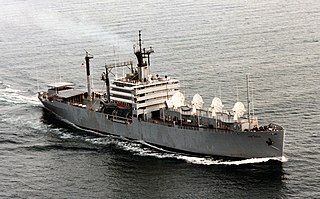
A tracking ship, also called a missile range instrumentation ship or range ship, is a ship equipped with antennas and electronics to support the launching and tracking of missiles and rockets. Since many missile ranges launch over ocean areas for safety reasons, range ships are used to extend the range of shore-based tracking facilities.

USS Sherburne (APA-205) was a US Navy Haskell-class attack transport, built and used during World War II. She was of the VC2-S-AP5 Victory ship design type. Sherburne was named for Sherburne County, Minnesota. She was later converted and renamed USS Range Sentinel (AGM-22), a missile range instrumentation ship.
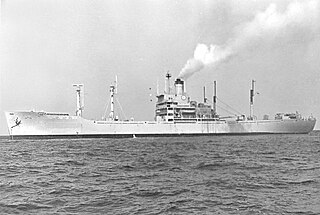
USNS Dutton (T-AGS-22) was an oceanographic survey ship for the United States Navy from the late 1950s through the 1980s. She was launched as SS Tuskegee Victory in 1945, Maritime Commission hull number MCV 682, a type VC2-S-AP3 Victory ship. In her U.S. Navy service, she was named after Captain Benjamin Dutton, Jr., and was the second U.S. Navy ship named in his honor.
USNS Michelson (T-AGS-23) was a Bowditch class oceanographic survey ship of the United States Navy. Launched as the SS Joliet Victory in 1944, Maritime Commission hull number MCV 114, a type VC2-S-AP3 Victory ship, she was named after Albert Abraham Michelson. The ship was reactivated from the James River Maritime Administration Reserve Fleet on 8 February 1958, delivered to the Navy Department at the Philadelphia Naval Shipyard on 8 August 1957 and converted to an AGS by the Charleston Naval Shipyard. USNS Michelson (AGS‑23) was placed in service on 15 December 1958 under the operational control of MSTS Atlantic.

SS Twin Falls Victory, named after Twin Falls, Idaho, was a Victory ship built for World War II. Converted to a Missile Range Instrumentation Ship, she was initially operated by the US Air Force as USAF Twin Falls Victory, before coming under US Navy control and being named USNS Twin Falls (T-AGM-11/T-AGS-37). She later had a third career as the training ship SS John W. Brown II.

SS Haiti Victory (T-AGM-238) was originally built and operated as Greenville class cargo Victory ship which operated as a cargo carrier in both the Atlantic Ocean and the Pacific Ocean during World War II.

USNS Private Joe E. Mann (T-AK-253) was a Boulder Victory-class cargo ship acquired in 1950, from the U.S. Army, where she was known as the USAT Private Joe E. Mann.
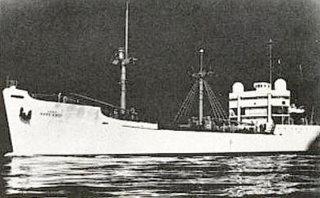
USNS Rose Knot (T-AGM-14) was a World War II era United States Maritime Commission small cargo ship built in 1945 and delivered to the War Shipping Administration for operation through agent shipping companies and for periods by the Military Sea Transportation Service (MSTS). In 1957 the ship was transferred to the Air Force and converted into a missile range instrumentation ship which operated as USAFS Rose Knot on the U.S. Air Force's Eastern Test Range during the late 1950s and early 1960s. Rose Knot operated under an Air Force contract with Pan American Airways Guided Missile Range Division headquartered in Cocoa Beach, Florida. In July 1964, all Air Force tracking ships were transferred to MSTS for operation with the Air Force in operational control while the ships were at sea as tracking ships. Rose Knot had special facilities for supporting the human spaceflight program and supported the early crewed flights. The ship was owned by the U.S. government until sold for non-transportation use in 1977.
USS Somerset (AK-212) was an Alamosa-class cargo ship that was constructed for the US Navy during the closing period of World War II. She was later acquired by the US Army in 1946 and the US Air Force in 1957 before being reacquired by the USN as the USNS Coastal Sentry (T-AGM-15), a missile range instrumentation ship.
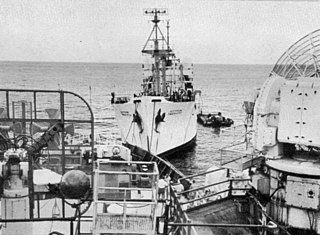
USNS Timber Hitch (T-AGM-17) was a US Navy missile range instrumentation ship which earlier operated as the US Air Force Ocean Range VesselUSAFS Timber Hitch (ORV-17) on the US Air Force's Eastern Test Range during the late 1950s and early 1960s. Timber Hitch operated under an Air Force contract with Pan American Airways Guided Missile Range Division headquartered in Cocoa Beach, Florida.

USNS Sgt. Curtis F. Shoup (T-AG-175) was a C1-M-AV1 coastal freighter. Built as Spindle Eye, one of the many named for knots. The ship, modified to be a "news transmission ship" for the press during the planned invasion of Japan, was completed 9 July 1945, delivered to the War Shipping Administration and placed under its agent Lykes Brothers Steamship Company the same day. Days later, on 26 July, Spindle Eye was bareboat chartered to the War Department for operation by the Army. The ship was renamed November 1947 by the Army, after serving as a radio relay ship at the Operation Crossroads atomic bomb tests and conversion to an Army passenger-cargo vessel, Sgt. Curtis F. Shoup in honor Sergeant Curtis F. Shoup who had been awarded the Medal of Honor.

USS Pembina (AK-200) – later known as USNS Pembina (T-AK-200) -- was an Alamosa-class cargo ship that was constructed for the U.S. Navy during the closing period of World War II. She supported the end-of-war Navy effort and was subsequently placed in service with the US Army under the Shipping Control Authority for the Japanese Merchant Marine with a Japanese crew in Yokosuka, Japan.
USNS Sgt. George Peterson (T-AK-248) was a US Maritime Administration (MARCOM) C1-M-AV1 type coastal cargo ship, originally planned as an Alamosa-class cargo ship. The contract for building was canceled by the Navy in August 1945. The ship, however, was completed as SS Coastal Guide. She was later acquired by the US Army, in 1948, and renamed USAT Sgt. George Peterson. She was reacquired by the Navy, in 1950, and placed in service by the Military Sea Transportation Service (MSTS) as USNS Sgt. George Peterson (T-AK-248). She remained with the Navy until struck in 1966. She was sold in 1971.
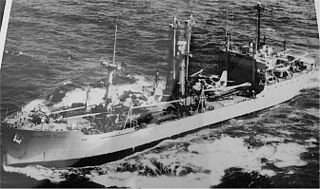
USNS Colonel William J. O’Brien (T-AK-246) was a US Maritime Administration (MARCOM) C1-M-AV1 type coastal cargo ship, originally planned as an Alamosa-class cargo ship. Constructed as Maiden's Eye for the MARCOM, completed in August 1945 and placed in operation by the War Shipping Administration (WSA). After the war Maiden's Eye was transferred to the US Army and renamed USAT Colonel William J. O’Brien who kept her in service until transferred to the US Navy in 1950 for operation as USNS Colonel William J. O’Brien (T-AK-246) by the Military Sea Transportation Service (MSTS) until 1973.
USNS Private John F. Thorson (T-AK-247) was a US Maritime Administration (MARCOM) C1-M-AV1 type coastal cargo ship, originally planned as an Alamosa-class cargo ship. Constructed as Becket Bend for MARCOM, completed in August 1945 and placed in operation by the War Shipping Administration. However, the war ended, and she was transferred to the US Army as USAT Private John F. Thorson who kept her in service until transferred to the US Navy in 1950. She was struck in 1960, ending her military career.
USNS Short Splice (T-AK-249) was a US Maritime Administration (MARCOM) C1-M-AV1type coastal cargo ship, originally planned as an Alamosa-class cargo ship. Constructed as Short Splice for MARCOM, completed in August 1945 and placed in operation by the War Shipping Administration during the closing period of World War II. However, the war ended, and she was transferred to the US Army as USAT Short Splice who kept her in service until transferred to the US Navy in 1950.

USNS Private Frank J. Petrarca (T-AK-250) was a US Maritime Administration (MARCOM) C1-M-AV1 type coastal cargo ship, originally planned as an Alamosa-class cargo ship. Constructed as Long Splice for MARCOM, completed in September 1945 and placed in operation by the War Shipping Administration (WSA) during the closing period of World War II. However, the war ended, and she was transferred to the US Army as USAT Private Frank J. Petrarca who kept her in service until transferred to the US Navy in 1950.














